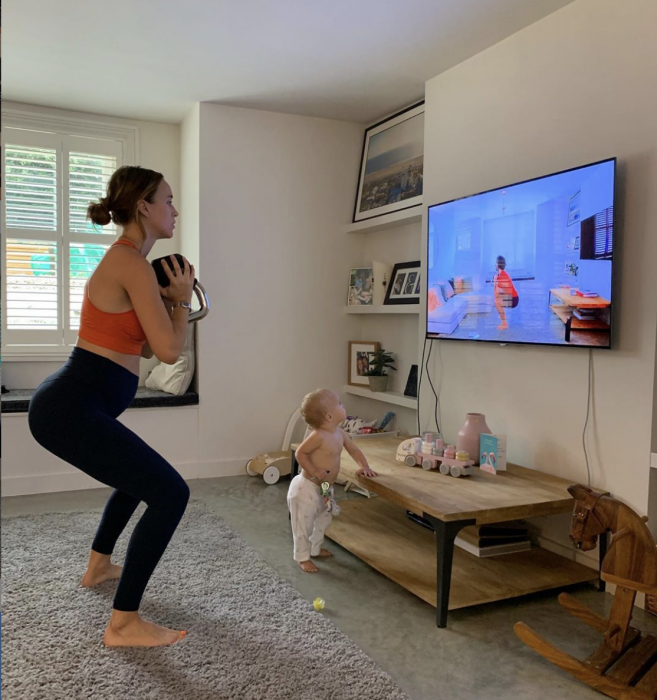“I’m in the best shape I’ve ever been at 45 – here’s how”
“This app has genuinely changed my life,” says Jill, 45, who joined The Body Coach in January 2025.
Sign up to The Body Coach newsletter to get inspiration in your inbox every Monday.

From how much exercise is recommended, to when to stop, what to avoid and how to work out in each trimester, here's everything you need to know about exercising during pregnancy. By freelance contributor, Charlotte Thomas.

For most mums-to-be, it's perfectly safe to keep exercising and enjoying your favourite workouts and sports. Staying fit and healthy has some great benefits for both you and your baby, and could mean you're less likely to experience problems in later pregnancy and labour, too.
Is it safe to exercise when pregnant?
Absolutely. "As long as you have the go-ahead from your medical team, then not only is it safe to exercise when you're pregnant, it's recommended," says Dr Brooke Vandermolen, an Obstetrics and Gynaecology doctor and blogger at The OBGYN Mum, who exercised regularly during both her pregnancies.
Exercise will help you adapt to your changing shape and ensure you're strong and fit for labour and motherhood.
Frankie Holah, a personal trainer specialising in pre and post-natal fitness agrees. "When I was pregnant, I looked at it like training for an event," she says. "I identified the specific strengths I'd need to support my changing body shape, to help me get through labour and prepare for the challenges of motherhood - like holding a baby for hours, lifting a car seat and feeding."
How much exercise should I be doing?
UK government guidelines recommend 150 minutes of moderate exercise with two muscle strengthening sessions a week during pregnancy. Muscle strengthening doesn't have to mean weights, this can be bodyweight movements or exercises using resistance bands. Muscle strengthening also includes those essential pelvic floor exercises!
[READ MORE: 5 ways to strength train without weights]
As with any form of exercise during pregnancy though, if you're not used to strength training make sure you seek the advice of a qualified trainer.
If you're already working out regularly, and have the go-ahead from medical professionals, the NHS says you can keep up with your usual sports or exercises, including running, yoga (with adaptations), dancing and walking, for as long as you feel comfortable. It's likely you'll need to lower the intensity and make adjustments throughout your pregnancy, but if you're feeling good you could still be exercising right up until the day you give birth.
For those who are less used to working out, Brooke recommends building things up gradually. "If you're not familiar with exercise, then your body will take some time to adapt to any form of intensity, and this is magnified during pregnancy," she says. "It's a good idea to build up slowly so you can test your own limits, and make sure you don't push yourself too far too quickly."
She advises starting with 15 minutes of continuous activity three times a week and gradually increasing this to 30 minutes of continuous activity at least four times a week.

What are the benefits of exercising while pregnant?
Exercising during pregnancy has many benefits for both you and your unborn child. Not only can it make you feel good, help reduce stress and boost self-esteem, but Brooke says that keeping active during pregnancy can also:
[READ MORE: 5 tips to a better night's sleep]
There are also benefits for anyone worried about gestational diabetes - high blood sugar, that develops during pregnancy and usually goes away after birth. "Observational studies have shown that exercise can reduce your likelihood of developing gestational diabetes as well as reducing the likelihood you'll require a caesarean section or operative vaginal delivery," says Brooke.
"For women who already have gestational diabetes, exercise can also improve glucose control, and prevent pre-eclampsia."

What are the best forms of exercise during pregnancy?
"Before starting any exercise regime when pregnant, it's a good idea to discuss your plans with your doctor or midwife," says Brooke, who did swimming, spinning, Pilates and at-home pregnancy-specific strengthening programmes during her pregnancies.
"In general, if you're used to doing a particular type of exercise, you can continue to do this in pregnancy, while taking additional precautions such as avoiding any contact sports, extremes of altitude or temperature and risks of falling."
Brooke suggests the following types of exercise are all considered safe and beneficial in pregnancy, even if you weren't particularly active before:
Frankie also strongly recommends functional strength training, which she did throughout her own pregnancy. Functional strength training uses resistance and bodyweight to mimic the demands of real-life activities.
"Functional strength training prepares your body for the changes and strains it will go through during each trimester, as well as for the birth itself and early motherhood," she says. "Strengthening your glutes, for example, will help with pelvic stability, while training your back will help to counteract the hunched position of feeding and carrying a baby."
"A qualified pre and post-natal trainer will be able to advise you on the best exercises for your body and ensure you're doing them properly to avoid injury. If you're able to afford it, I'd also advise visiting a Women’s Health physiotherapist, both during and after your pregnancy."
"Women's Health physios specialise in issues associated with pregnancy, birth and postpartum. They provide you with more knowledge about how your pelvic floor is functioning and teach you how to correctly perform those all-important Kegels."
"Your physio will also guide you with exercises to improve pelvic health both during and after your pregnancy."
Are there any types of exercise to avoid during pregnancy?
How much and what type of exercise you can do is very individual, but some forms aren't generally considered suitable during pregnancy or are best performed only under the supervision of a qualified instructor, and if you're unsure always check with a professional. These include:
Should I tell my exercise instructor I'm pregnant?
Definitely. Even if you haven't informed your family yet, make sure you have a private word with your exercise instructor to tell them you're pregnant and how many weeks you are. They'll then be able to let you know if their class is safe during pregnancy, if they're qualified to instruct you at this time and offer alternatives or modifications for any unsuitable exercises.
Keeping fit in each trimester
First trimester
During your first trimester you may feel tired and nauseous. Your blood pressure decreases, which can leave you feeling faint, the volume of blood being pumped by your heart increases, which can lead to a rapid heart rate, and exercise might well be the last thing on your mind.
If you don't feel able to exercise, don’t worry. "It's important to be kind to yourself and work within your own limits," says Brooke. "So many changes are taking place in your body within a short space of time and it's normal to feel dizzy or fatigued. You may prefer to reduce or stop your usual exercise routine until you're feeling better and some of the early pregnancy symptoms have subsided. This is unlikely to have any long-term effect."
Frankie agrees. "Some people will feel fine and able to exercise as normal, but at this stage I felt pretty grim," she says. "I kept any exercise low-intensity and went for walks instead of doing gym sessions."
Second trimester
By the second trimester you may well be feeling better and (hopefully) the morning sickness will have lessened.
"This is the time when a lot of my clients feel able to enjoy working out again," says Frankie. "With improved energy levels, you should be ready to enjoy exercise in a way you weren't able to during the first trimester."
Third trimester
Your growing bump may make exercising awkward and carrying the extra weight can be tiring. Swimming can be a good weight-bearing option, but don't worry too much if you don’t feel able to hit the gym.
"Remember, keeping moving is beneficial," says Frankie. "At this stage, simply walking, getting in some daily stretches and, for me, taking the stairs, is enough."
Click here to follow Frankie Holah on Instagram. Click here to follow Brooke Vandermolen Instagram.